Are you curious about how big is a queen-sized bed and whether it’s the right choice for your bedroom? While many believe a queen-sized bed is the perfect fit for any room, this isn’t always true. In this guide, we’ll uncover the exact dimensions and explore the benefits to help you determine if a queen-size bed truly meets your needs.
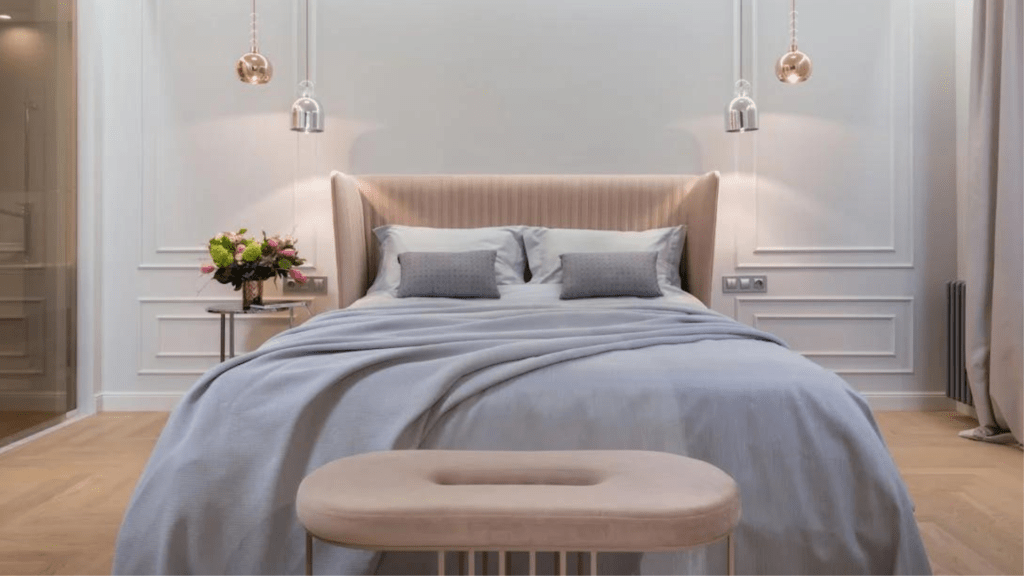 How wide a queen-sized bed is with DreamyBedroom.
How wide a queen-sized bed is with DreamyBedroom.Have you ever stood in a mattress store, overwhelmed by the options? You’re not alone. Choosing the right bed size can be tricky, especially when balancing comfort, space, and budget.
What is a Queen Size Bed?
So, what exactly is a queen size bed? Simply put, a queen-size bed is a type of bed that offers a balance between space and comfort. It’s a popular choice for couples and individuals who want extra room to stretch out. If you’re wondering how wide is a queen size bed, it typically measures around 60 inches in width, providing ample space for a comfortable night’s sleep
Standard Dimensions of a Queen Size Bed
The standard dimensions of a queen size bed are 60 inches wide and 80 inches long. This size gives you ample space without overwhelming your bedroom. For context, it’s 6 inches wider and 5 inches longer than a full-size bed. These dimensions make it a great option for most rooms, providing enough space for two people to sleep comfortably without taking up the entire room.
If you’re wondering about variations, there are slight differences based on regions. In the UK, for example, a queen-sized bed is often referred to as a “king” and measures 60 inches by 78 inches. But for most purposes, when you hear “queen size bed,” it’s the 60 by 80 inches standard. To put it in perspective, the queen-sized bed dimensions in feet are 5 feet wide by 6.67 feet long.
Variations
While the standard queen size is quite common, there are a few variations you might come across. One of these is the Olympic Queen, which is 66 inches wide and 80 inches long. This gives a bit more width, making it an excellent choice for those who want extra space without jumping up to a king-size bed. Another variation is the California queen, measuring 60 inches wide by 84 inches long. This adds extra length, perfect for taller individuals.
Benefits of a Queen Size Bed
A queen-size bed is worth upgrading because the benefits of a queen-size bed go beyond just a few extra inches. Let’s explore why queen-sized bed dimensions could be the perfect choice for you.
Ideal for Couples
One of the biggest advantages of a queen-sized bed is its suitability for couples. Sharing a bed can sometimes feel cramped, especially on a full-size bed. A queen bed, with its 60-inch width, provides more space for each person to move comfortably during the night. This extra space can significantly improve sleep quality, as both partners have more room to find their perfect sleeping position.
If you’re used to a smaller bed, upgrading to a queen can feel like a luxurious change. It’s also a great compromise if your bedroom can’t accommodate a king-size bed but you still want more space than a full-size bed offers. For those looking for even more room, a California queen-size bed might be the perfect solution, offering additional length for taller individuals while maintaining the standard queen-width.
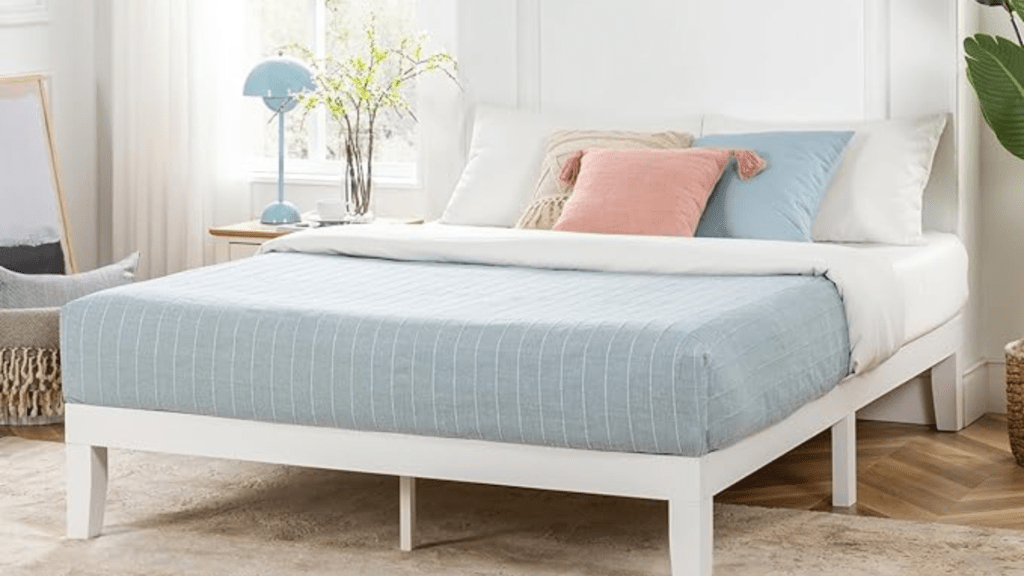
Space Efficiency
Another great benefit of a queen-sized bed is its balance between comfort and space efficiency. While a king-size bed might seem appealing, it can overwhelm smaller bedrooms and leave little room for other furniture. A queen bed, on the other hand, fits comfortably in most bedrooms without making the space feel cramped.
This makes it a versatile option for different types of rooms, whether it’s a master bedroom, a guest room, or even a spacious studio apartment. You can enjoy ample sleeping space while still having room for nightstands, dressers, or a seating area.
Versatility
Queen-size beds are incredibly versatile. They’re not just great for couples; they’re also an excellent choice for single sleepers who like to spread out. If you often find yourself tossing and turning or if you simply enjoy having extra room to move, a queen bed provides that extra space.
Additionally, queen beds are a popular choice for guest rooms. They offer a comfortable sleeping arrangement for visitors, whether they’re couples or solo travelers. This versatility means that investing in a queen-sized bed is almost always a good idea, as it can adapt to different needs over time.
Comparing Queen Size Beds to Other Bed Sizes
Many people believe that bigger is always better when it comes to bed sizes. However, the right bed size depends on your specific needs and space. Let’s break down the differences between a queen-size bed and other common bed sizes to help you make an informed choice.
Queen vs. King: Differences in Size and Suitability
A common dilemma is choosing between a queen and a king-size bed. While a king-size bed is larger, measuring 76 inches wide and 80 inches long, it’s not always the best choice for every room.
Space Considerations:
A king-size bed offers more space, ideal for couples who want maximum room to move around. However, it requires a larger bedroom, at least 12×12 feet, to avoid a cramped feel.
A queen-size bed, with its 60-inch width and 80-inch length, fits better in average-sized bedrooms, making it a more versatile option for most homes.
Suitability:
A queen bed is perfect for couples who enjoy close sleeping but still need some personal space. It’s also great for guest rooms or smaller master bedrooms.
A king bed suits those with larger rooms who prioritize spacious sleeping areas and can accommodate the extra width without compromising other furniture.
Queen vs. Full: Which One to Choose Based on Room Size
Choosing between a queen and a full-size bed depends largely on your room size and sleeping needs.
Dimensions Comparison:
A full-size bed measures 54 inches wide and 75 inches long. While it’s 6 inches narrower and 5 inches shorter than a queen, it can feel significantly smaller.
A queen-sized bed provides more room to stretch out, making it a better choice for couples or individuals who need more space to move around.
Room Fit:
Full beds are suitable for smaller rooms, such as guest bedrooms or studio apartments, where space is limited.
Queen beds are more comfortable for regular use, especially if you have a medium to large bedroom.
Queen vs. Twin: When a Queen Size Might Be Too Big
While a queen-sized bed offers ample space, there are times when a twin bed might be a better fit.
Size Difference:
A twin bed measures 38 inches wide and 75 inches long, much smaller than a queen. It’s ideal for single sleepers, children, or small guest rooms.
A queen bed, being almost twice the width of a twin, provides significantly more sleeping space but requires more room.
Appropriate Use Cases:
Twin beds are great for children’s rooms, bunk beds, or rooms where you need to maximize floor space.
Queen beds are better for adults or couples who need more space to sleep comfortably.
Choosing the Right Queen Size Bed for Your Room
Some might think that any queen-size bed will fit perfectly in every bedroom, but that’s not always the case. Choosing the right queen-size bed involves considering your room size, mattress type, and the bed frame. Let’s break down how to make the best choice for your space.
Room Size Considerations
First things first, you need to measure your room. A queen-sized bed is 60 inches wide and 80 inches long, but you need to account for additional space around the bed for movement and other furniture.
Measuring Your Room:
Start by measuring the length and width of your room. Don’t forget to consider the placement of doors, windows, and any built-in furniture.
Ensure there’s at least 2-3 feet of space on each side of the bed for easy movement. This means a room should ideally be at least 10×10 feet to comfortably fit a queen size bed.
Optimal Room Layout:
Think about the layout of your room. Where will the bed be positioned? Will you have space for nightstands on both sides?
Consider the flow of the room. Make sure the bed’s placement doesn’t obstruct any pathways or make the room feel cramped.
Mattress Types
Choosing the right mattress is crucial for a good night’s sleep. There are various types of mattresses available for queen-size beds, each offering different levels of comfort and support.
Types of Mattresses
The different types of mattresses are available to find the perfect one for your sleep needs. From memory foam and innerspring to hybrid and latex, each mattress type offers unique benefits for a comfortable night’s rest.
Memory Foam
Conforms to your body, offering excellent support and pressure relief. Ideal for those who need extra support or suffer from joint pain.
Innerspring
Traditional choice with coils providing support and a bouncy feel. Great for those who prefer a firmer mattress.
Hybrid
Combines memory foam and innerspring for balanced support and comfort. Suitable for those who want the best of both worlds.
Latex
Offers a responsive feel and is naturally hypoallergenic. Perfect for those who prefer an eco-friendly option and need good support.
Choosing the Right Mattress
Think about your sleep preferences and any specific needs. Do you need a firmer mattress for back support or a softer one for comfort?
Test different mattresses if possible. Spending some time lying on a mattress in-store can help you find the perfect fit.
Bed Frames and Accessories
The bed frame you choose can impact the look and functionality of your bedroom. Let’s look at some options and considerations.
Types of Bed Frames
The various types of bed frames complement your bedroom decor and support your mattress. Choose from platform beds, adjustable frames, canopy beds, and more to suit your style and comfort preferences.
Platform Beds
Platform beds provide a modern look and often come with built-in storage, making them great for saving space. Their low profile and sleek design can also make a bedroom appear more spacious. Additionally, platform beds eliminate the need for a box spring, offering a more cost-effective and minimalist option for your sleeping arrangements.
Four-Poster Beds
Four-poster beds add a touch of elegance and grandeur, making them ideal for larger rooms with high ceilings. Their tall posts and often intricate designs can create a focal point in the bedroom, enhancing the overall decor. Additionally, they offer the opportunity to drape curtains or canopies, providing a cozy and romantic ambiance.
Storage Beds
Storage beds include drawers or compartments for additional storage, making them perfect for small rooms where space is at a premium. These beds help keep your bedroom organized by providing a convenient place to store extra bedding, clothing, or other items. Their practical design ensures that every inch of space is utilized efficiently, making them a smart choice for maximizing your room’s functionality.
Adjustable Beds
Allow you to change the position of the mattress. Good for those with specific health needs or who enjoy reading in bed. They can provide relief from conditions such as acid reflux, snoring, or back pain by allowing for customized sleeping positions. Additionally, these beds often come with features like massage functions and zero-gravity settings, enhancing comfort and relaxation.
Accessories
Enhance your bedroom with essential accessories like headboards, bedside tables, and quality bedding. These additions can significantly improve your comfort, support, and overall sleep quality. A stylish headboard can serve as a focal point, while bedside tables provide convenient storage for nighttime essentials. High-quality bedding not only offers a luxurious feel but also contributes to a better night’s sleep, ensuring you wake up refreshed and ready for the day.
Headboards
Headboards can add both style and comfort to your bedroom. Choose one that complements your room’s decor to create a cohesive look. Upholstered headboards offer a plush, comfortable surface to lean against, perfect for reading or watching TV in bed. Wooden or metal headboards can bring a touch of elegance or a modern vibe, enhancing the overall aesthetic of your sleeping space.
Bedside Tables
Bedside tables ensure you have enough space for essentials like lamps, books, and personal items. They help keep your nighttime necessities within arm’s reach, adding both convenience and functionality to your bedroom. Additionally, bedside tables come in various styles and sizes, allowing you to choose one that matches your decor and meets your storage needs, from minimalist designs to those with multiple drawers for extra storage.
Bedding
High-quality sheets, pillows, and comforters enhance comfort and can significantly improve your sleep quality. Choose materials that suit your climate and personal preferences, such as breathable cotton for warmer climates or cozy flannel for cooler months. Investing in hypoallergenic options can also be beneficial for those with allergies, ensuring a healthier sleep environment. Additionally, coordinating colors and patterns with your bedroom decor can create a harmonious and inviting atmosphere.
Tips for Decorating Around a Queen Size Bed
A common misconception is that a queen size bed limits your decorating options due to its size. However, with some thoughtful planning, you can create a beautifully decorated room that feels spacious and stylish. Here are some tips to help you decorate around your queen size bed.
Maximizing Space
Maximizing space is crucial, especially in smaller rooms. Here’s how you can do it:
Smart Furniture Placement:
Position your bed against the longest wall to create a sense of space. Place nightstands on either side of the bed for balance and symmetry. Choose compact designs to save space. Consider using wall-mounted shelves instead of bulky dressers to keep the floor area open. Arrange larger pieces of furniture first to establish a layout, then fill in with smaller items to maintain a functional and spacious feel.
Multi-functional Furniture
Opt for furniture pieces that serve multiple purposes, like storage benches or ottomans at the foot of the bed. These not only provide extra seating or storage but also add visual interest to your bedroom decor.
Consider wall-mounted shelves instead of bulky bookcases to keep the floor space clear and create a more open feel. This allows you to display items while maintaining a streamlined look, ideal for smaller rooms or minimalist design preferences.
Under-Bed Storage
Utilize the space under your bed for storage by investing in storage bins or drawers that can slide easily under the bed. This area is perfect for storing seasonal items, extra bedding, or belongings you don’t need daily access to.
If you’re using a platform bed with built-in storage, consider organizing items like seasonal clothing or spare linens here to free up closet space for everyday essentials. This not only keeps your bedroom tidy but also ensures everything is easily accessible when needed.
Creating a Focal Point
Your queen-sized bed can be the focal point of your bedroom, setting the tone for the entire space. Enhance its prominence with a stylish headboard, complemented by coordinated bedding and decorative pillows. Consider placing it against a feature wall painted in a contrasting color or adorned with artwork to draw attention and create a visually appealing centerpiece in your room.
Headboards
Headboards can transform the look and feel of your bedroom. Choose a stylish headboard that complements your room’s decor, whether it’s upholstered for a touch of luxury or wooden for a rustic or minimalist vibe. If you want to make a bold statement, opt for a tall, dramatic headboard that commands attention and adds a striking focal point to your sleeping space. This can elevate the overall aesthetic and create a sense of style and sophistication in your bedroom design.
Accent Wall
Create an accent wall behind your bed using paint, wallpaper, or textured materials to draw attention and add depth to the room. Choose colors or patterns that contrast with the rest of the room’s palette to make the wall stand out as a focal point. Consider incorporating decorative elements like wall-mounted lighting fixtures or framed artwork to further enhance the visual impact and create a cohesive, inviting atmosphere in your bedroom.
Art and Decor:
Hang artwork, mirrors, or decorative pieces above the headboard to complement the bed’s size and the wall space. Ensure they are proportionate to create a balanced visual impact in the room.
Consider adding sconces or pendant lights on either side of the bed for both style and functionality. These lighting fixtures not only illuminate your reading or relaxation area but also contribute to the overall ambiance and aesthetic appeal of your bedroom decor.
Balancing the Room
Balancing the room ensures it feels cohesive and well-organized, even with a large bed.
Symmetry and Proportion
Maintain symmetry by placing matching nightstands and lamps on either side of the bed. This creates a balanced and harmonious look.
Ensure other furniture pieces are proportionate to the queen-size bed. Avoid oversized dressers or chairs that can make the room feel cramped.
Lighting
Layer your lighting with a combination of overhead lights, bedside lamps, and ambient lighting. This creates a warm and inviting atmosphere.
Use dimmable lights to adjust the brightness according to your needs and mood.
Rugs and Textiles
Place an area rug under the bed to anchor the space. Ensure the rug extends beyond the edges of the bed to create a unified look.
Choose bedding and pillows that complement your room’s color scheme. Mix and match textures for added interest and comfort.
Personalizing Your Space
Adding personal touches to your bedroom makes it feel uniquely yours.
Photos and Keepsakes:
Display framed photos, souvenirs, or personal mementos on shelves or walls. This adds a personal touch and makes the space feel more intimate.
Use a gallery wall to showcase a collection of your favorite pieces. Arrange them in a visually appealing layout.
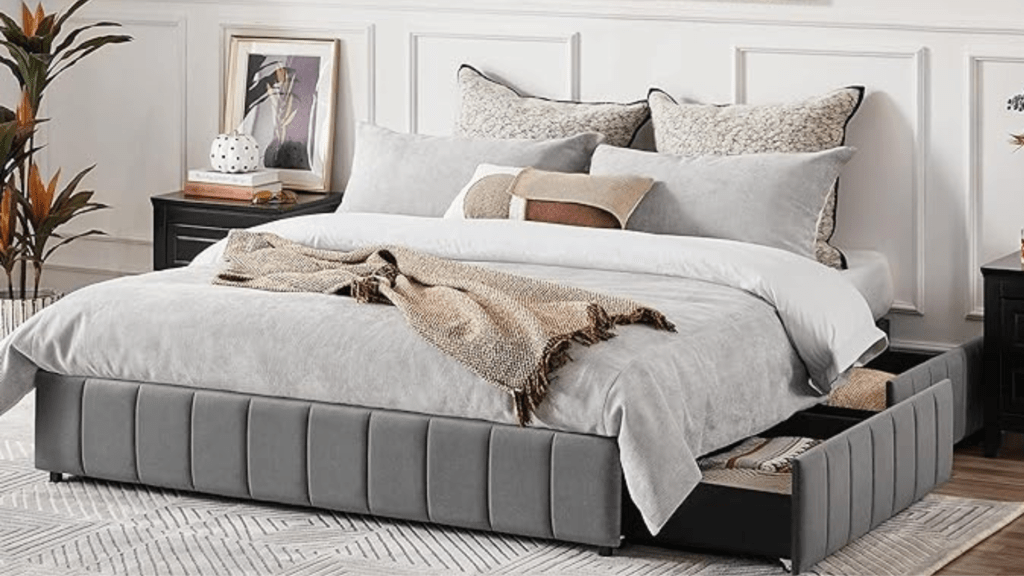
Plants and Greenery:
Incorporate plants to bring life and color into the room. Choose low-maintenance plants like succulents or snake plants if you’re not a green thumb.
Place plants on windowsills, shelves, or even hanging planters to add greenery without taking up too much space.
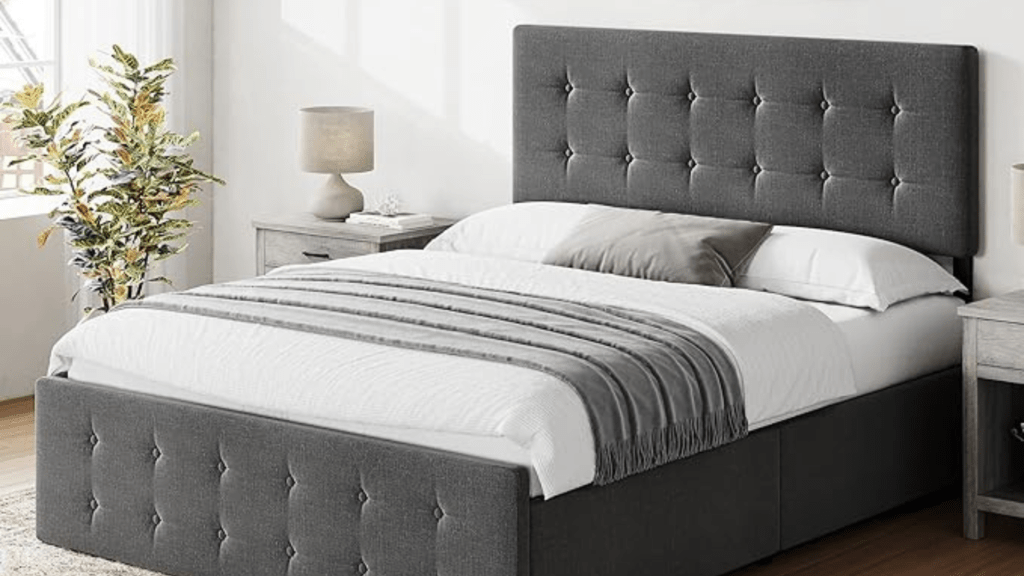
Bedding and Throws:
Select bedding that reflects your style. Whether you prefer bold patterns, neutral tones, or luxurious fabrics, choose pieces that make you feel comfortable and happy.
Add throws and cushions in complementary colors to enhance the look and feel of your bed.
Common Myths About Queen-Size Beds
Many people believe that queen-size beds are a one-size-fits-all solution for every bedroom. While queen-size beds are versatile, several myths about them need debunking.
Myth: Queen Size Beds Are Too Large for Small Rooms
One common belief is that queen-size beds are too big for small bedrooms. However, with smart planning, a queen bed can fit comfortably in a smaller space.
Debunking the Myth
Common misconceptions about sleep and mattresses to make informed decisions about your sleep environment. Learn the truth behind myths like firm mattresses are always better and more expensive means higher quality.
Space Management
As we discussed earlier, placing the bed against the longest wall and utilizing under-bed storage can maximize space.
Multi-functional Furniture
Using compact and multi-functional furniture helps keep the room organized and spacious. Nightstands with built-in drawers, wall-mounted shelves, and foldable desks are great options.
By carefully planning your layout, even a small room can accommodate a queen-sized bed without feeling cramped.
Myth: Queen Size Beds Are Only for Couples
Another myth is that queen-size beds are only suitable for couples. In reality, queen-size beds are ideal for various situations.
Debunking the Myth
Contrary to popular belief, queen-size beds are versatile options suitable for individuals who enjoy extra space or couples who prefer ample room to stretch out comfortably. They provide flexibility in bedroom layout and are ideal for single sleepers who prioritize comfort and space.
Single Sleepers
For single sleepers who enjoy extra space to stretch out, a queen bed offers more comfort compared to a twin or full bed.
Guest Rooms
A queen size bed is perfect for guest rooms, providing ample space for guests to sleep comfortably.
Growing Teenagers
As children grow into teenagers, a queen bed can provide them with the space they need, especially if they have outgrown their twin bed.
This versatility makes queen-size beds a popular choice for different needs.
Myth: All Queen Size Beds Are the Same
Many assume that all queen-size beds are created equal. However, the variety in materials, designs, and features can significantly impact your comfort and the bed’s durability.
Debunking the Myth
Not all queen-size beds are created equal—variations exist in dimensions, materials, and construction, influencing comfort and suitability for different sleep preferences. Understanding these differences ensures you can choose a queen-size bed that best fits your specific needs and enhances your sleep quality.
Material and Build Quality
Different materials, such as memory foam, innerspring, latex, and hybrids, offer varying levels of comfort and support. Choose based on your personal preference and sleeping habits.
Design Options
From platform beds to four-poster beds, the design can influence both the aesthetics and functionality of your bedroom. Select a design that complements your decor and meets your storage needs.
Understanding these differences can help you choose a queen bed that perfectly fits your requirements.
Conclusion
Choosing the right queen-size bed involves more than just picking the largest bed that fits in your room. It’s about considering your space, understanding your sleeping needs, and debunking common myths to make an informed decision.
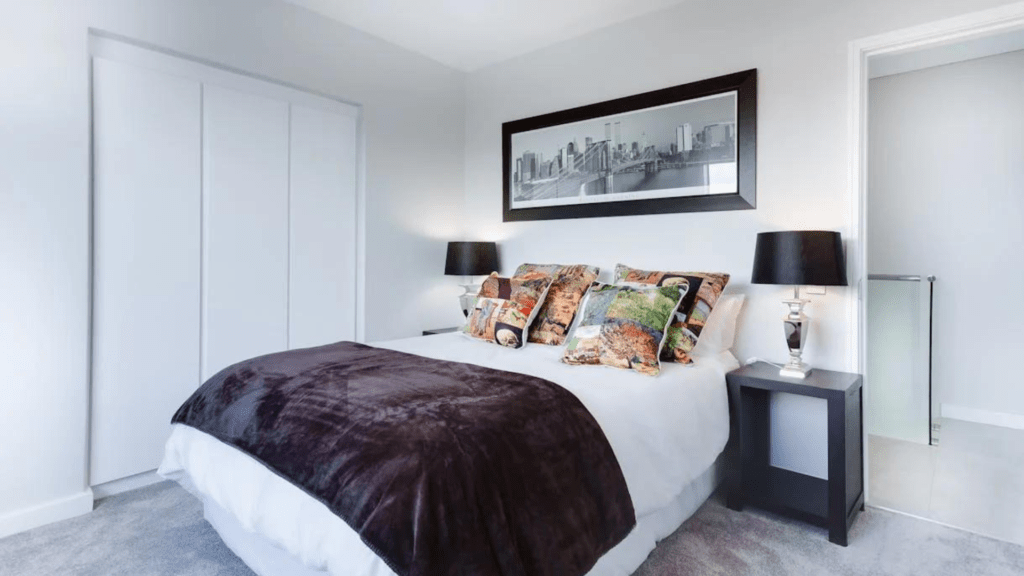
Measure your room to ensure a queen bed fits comfortably without overcrowding. Utilize under-bed storage and multi-functional furniture to maximize space.
Choose the right mattress type—memory foam, innerspring, hybrid, or latex—based on your comfort preferences. Select a bed frame that complements your room’s decor and offers additional functionality, like storage or adjustability.
Use smart furniture placement, an accent wall, and well-chosen decor items to create a balanced and aesthetically pleasing bedroom. Personalize your space with photos, plants, and textiles that reflect your style.
A queen size bed can fit in small rooms with proper planning. It’s suitable for singles, couples, guest rooms, and growing teenagers. Not all queen-size beds are the same; consider material and design options.
By following these tips, you can ensure that your queen-size bed enhances your room’s comfort and style, making it a perfect sanctuary for relaxation.

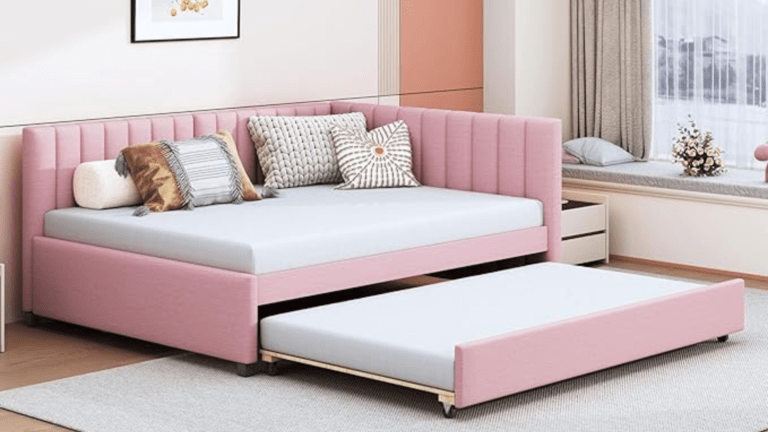
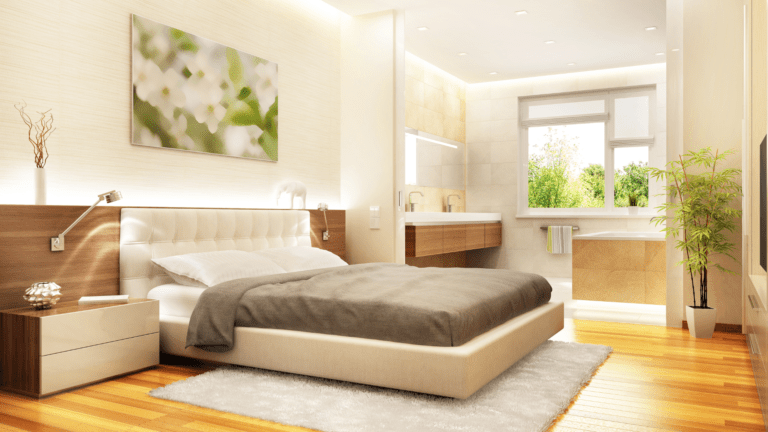

Pingback: California King vs King Bed Dimensions Comparison
QHXBEwesud
Pingback: Hardwood Queen Bed to Transform Your Bedroom
Pingback: 10 Benefits to Choose a Twin Over Queen Bunk Bed for Your Home - Dreamy Bedroom